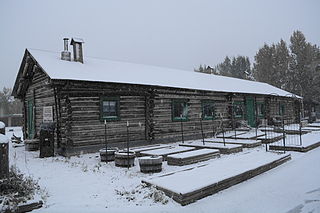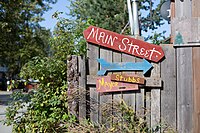
Talkeetna is a census-designated place (CDP) in Matanuska-Susitna Borough, Alaska, United States. At the 2020 census the population was 1,055, up from 876 in 2010.

Grand Canyon Depot, also known as Grand Canyon Railroad Station, was constructed in 1909–10 for the Atchison, Topeka and Santa Fe Railway at the South Rim of the Grand Canyon, in what is now Grand Canyon National Park. It is one of three remaining railroad depots in the United States built with logs as the primary structural material. The station is within 330 feet (100 m) of the rim of the canyon, opposite the El Tovar Hotel, also built by the railroad. The depot is designated a National Historic Landmark, is listed the National Register of Historic Places, and is included in the Grand Canyon Village National Historic Landmark District.

The Black Rapids Roadhouse, also known as the Rapids Roadhouse and the Rapids Hunting Lodge, is a historic Alaskan structure along the Richardson Highway in east-central Alaska. It was built in 1902. Construction of the Alaska Railroad led to a decline in the 1920s, but the original roadhouse continued to operate until 1993. A new, modern lodge was built near the roadhouse in 2001 and the original building is preserved as a historical curiosity and tourist attraction.

The Coal Creek Historic Mining District is a gold-mining area in the Yukon-Charley Rivers National Preserve of Alaska dating from the 1930s. It features a gold dredge and a supporting community of several dozen buildings, established by mining entrepreneur Ernest Patty.

Rika's Landing Roadhouse, also known as Rika's Landing Site or the McCarty Roadhouse, is a roadhouse located at a historically important crossing of the Tanana River, in the Southeast Fairbanks Area, Alaska, United States. It is off mile 274.5 of the Richardson Highway in Big Delta.

The Talkeetna Roadhouse is a historically significant Alaskan frontier roadhouse dating from the early 20th century. It is situated in the town of Talkeetna, Alaska in the northern United States.

The Woodchopper Roadhouse, on the Yukon River, is a historic establishment that was built in approximately 1910. It is located in the Yukon-Charley Rivers National Preserve. It served as a hotel and as a post office. Its log building was listed on the National Register of Historic Places in 1987.
The Central House, also known as Erickson & Stade's, at Mile 128 on the Steese Highway in Central, Alaska, was a log structure built in 1926 by Riley Erickson and John Stade, replacing an 1894 log and sod structure that was burned in a 1925 fire. It served as a roadhouse restaurant and hotel, and was listed on the National Register of Historic Places in 1978.

The Slana Roadhouse, on Nabesna Road in Slana, Alaska, in the Valdez-Cordova Census Area, is a historic site dating to 1928. The site was listed on the National Register of Historic Places in 2005. The listing included four contributing buildings on 5 acres (2.0 ha).

The Fairview Inn is a historic hotel building on Main Street in the center of Talkeetna, Alaska, United States. It is a two-story frame structure, with a hip roof. The main block, 36 feet (11 m) square, was built between 1920 and 1923, following the arrival in the area of the Alaska Railroad. The building exterior is little-altered since then; its major modification has been the addition in the 1970s of an addition for owner living quarters. The interior also still follows essentially the same floor plan as when it was built.

The Chicken Historic District encompasses part of the historic mining district of Chicken, Alaska. It is located at milepost 66.5 on the north side of the Taylor Highway, and includes fifteen buildings built between 1908 and 1967. Most of these are single-story wood-frame structures, with either metal or board-and-batten siding, although there are also some log structures. Many of these buildings were erected by the Fairbanks Exploration Company, which ran the gold mining operations in the area. Notable buildings include the bunkhouse, a gabled log structure, and the Chicken Creek Roadhouse, built in 1906, which was originally two stories in height but was reduced to a single story in 1924. The district also includes a section of water pipeline built by the company to bring water to the area from Mosquito Creek, a distance of about 1 mile (1.6 km). The camp was used until the company ended mining operations in 1967.

The Gakona Historic District encompasses the historic settlement of Gakona, Alaska, which was established as a stagecoach stop on what is now the Glenn Highway in eastern Alaska. The district includes the original Gakona Roadhouse, dating to 1904, and a cluster of buildings around the 1926-28 Gakona Lodge just to its south: two cabins, a horse barn, carriage house, bar, and house. All but two of these are of log construction, and most were built either c. 1904 or 1926–28, when the highway was rebuilt to a higher standard.

The Gakona Roadhouse is a historic traveler service facility in Gakona, Alaska, at mile 205 of the Glenn Highway. It is a 1-1/2 log structure with a gabled roof covered in corrugated metal. A shed-roof addition extends to the main block's east side. The roadhouse was built c. 1904, during the construction by the United States Army of the Trans-Alaska Military Road between Valdez and Eagle. This roadhouse was strategically located at a place where that road diverged from the old Eagle Trail, used by miners to reach the gold rush fields of the Yukon River. The original 1904 structure is used for storage; the present roadhouse facilities are provided by later (1920s) structures.

The Steele Creek Roadhouse is a historic roadhouse, post office, and trading post in east-central Alaska. It is located on the south side of the Fortymile River, at the mouth of Steele Creek, and is accessible via a hiking trail from mile 105 of the Taylor Highway, or by river access. It is a two-story log structure, 50 feet (15 m) wide and 25 feet (7.6 m) deep. Its first story was built c. 1898 by a man named Anderson, with the second story added in about 1910. It was on the main route between Eagle and Chicken between 1907 and 1951, serving travelers and local residents, until the Taylor Highway bypassed it. It underwent restoration in 2011.
Kirsch's Place, also known as the Fireweed Station Lodge, and now the Fireweed Station Inn, is a historic traveler accommodation near Talkeetna, Alaska. It is located about 10.5 miles (16.9 km) south of Talkeetna, roughly 200 feet (61 m) east of mile 215.3 of the Alaska Railroad, a place known as Sunshine Siding. It is a 1+1⁄2-story log structure, built in 1946 by John Kirsch as a residence and guest lodge. Kirsch operated the lodge until his death in 1959. The lodge is a rare survivor of a post-World War II rural building boom, which was later eclipsed as roads and settlement in the area became more prevalent.

The Knik Site, also known as the Old Knik Townsite, is the location in Matanuska-Susitna Borough, Alaska that was once home to the largest settlement on Cook Inlet. The only surviving remnants of the community are a former log roadhouse, now a museum operated by the Wasilla-Knik Historical Society, and a log cabin. The Knik area had long been a meeting point of Native Alaskans, and in 1898 it became the principal community on Cook Inlet from which goods were shipped into the interior. In 1916 the Alaska Railroad reached the site of present-day Anchorage, bypassing Knik and leading to Anchorage's growth. When the railroad reached Wasilla, Knik lost all importance as a transshipment point, and its buildings were either abandoned or moved to one of the other communities. Knik is located about 13 miles (21 km) southwest of Wasilla.

The Sullivan Roadhouse is a restored historic traveler's accommodation, operated as a museum in Delta Junction, Alaska, United States. The roadhouse was added to the National Register of Historic Places in 1979.

The Talkeetna Airstrip is a historic runway in Talkeetna, Alaska. It is a rectangular area of land, covered by grass and gravel, extending southward along D Street from First Street toward the Susitna River. It is about 1,800 feet (550 m) long and 30 feet (9.1 m) wide, with its northern stretch now lined with private residences and its southern stretch surrounded by public woodlands. The airstrip was created in 1940 as the result of a presidential executive order issued by President Franklin Delano Roosevelt in 1937, which set aside federal land near Talkeetna for aviation-related purposes. It played a major role in the economic development of the community, as air transport was the most reliable method of bringing supplies and travelers into the area.
Pilgrim Hot Springs is a ghost town in the interior of the Seward Peninsula of northwestern Arctic Alaska. Also known as Kruzgamepa, it is located on the southeast bank of the Kruzgamepa River, about 8 miles (13 km) south of milepost 65 of the Kougarok Road. The location gained prominence in the early 20th century because of its thermal hot springs, which made agricultural homesteading possible, and which were adapted to provide a respite for the gold miners of Nome. Early buildings, built 1900–03, were of log construction, and included a log cabin, barn and chicken house. A roadhouse and saloon were built after 1903, but were destroyed by fire in 1908, after the mining boom had ended.

The Solomon Roadhouse, also known as the Curran's Roadhouse, is a historic travel accommodation in northwestern Arctic Alaska. It is a two-story frame building located a short way north of the small community of Solomon, which is at the mouth of the Solomon River about 30 miles (48 km) east of Nome on the Nome-Council Highway. The roadhouse was built in 1904, during the days of the Nome Gold Rush, which brought many miners to the Solomon River as well, resulting in the establishment of the communities of Solomon and Dickson, and the construction of a railroad. After the gold rush declined and the communities were devastated by storms and floods, the roadhouse and other buildings were relocated about a mile north of the coast in the 1930s. The roadhouse operated until the 1970s.






















